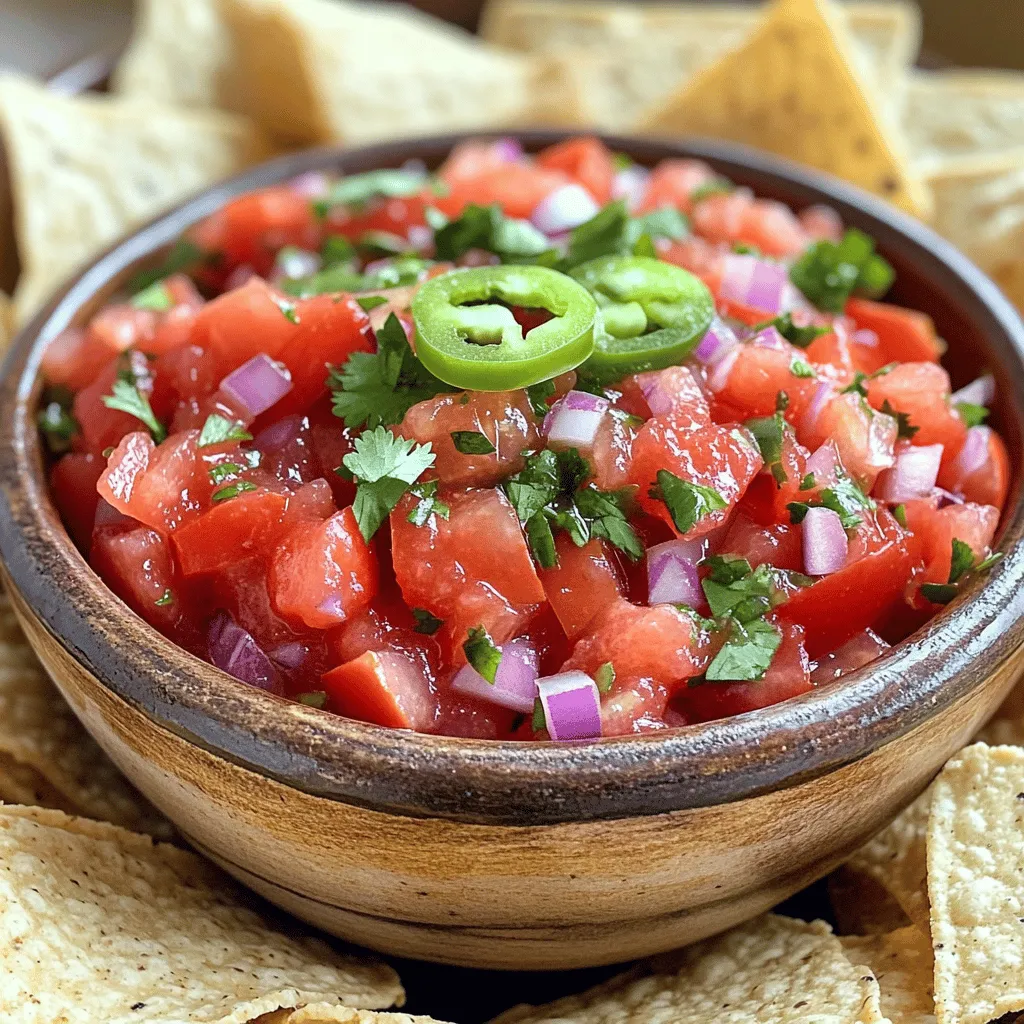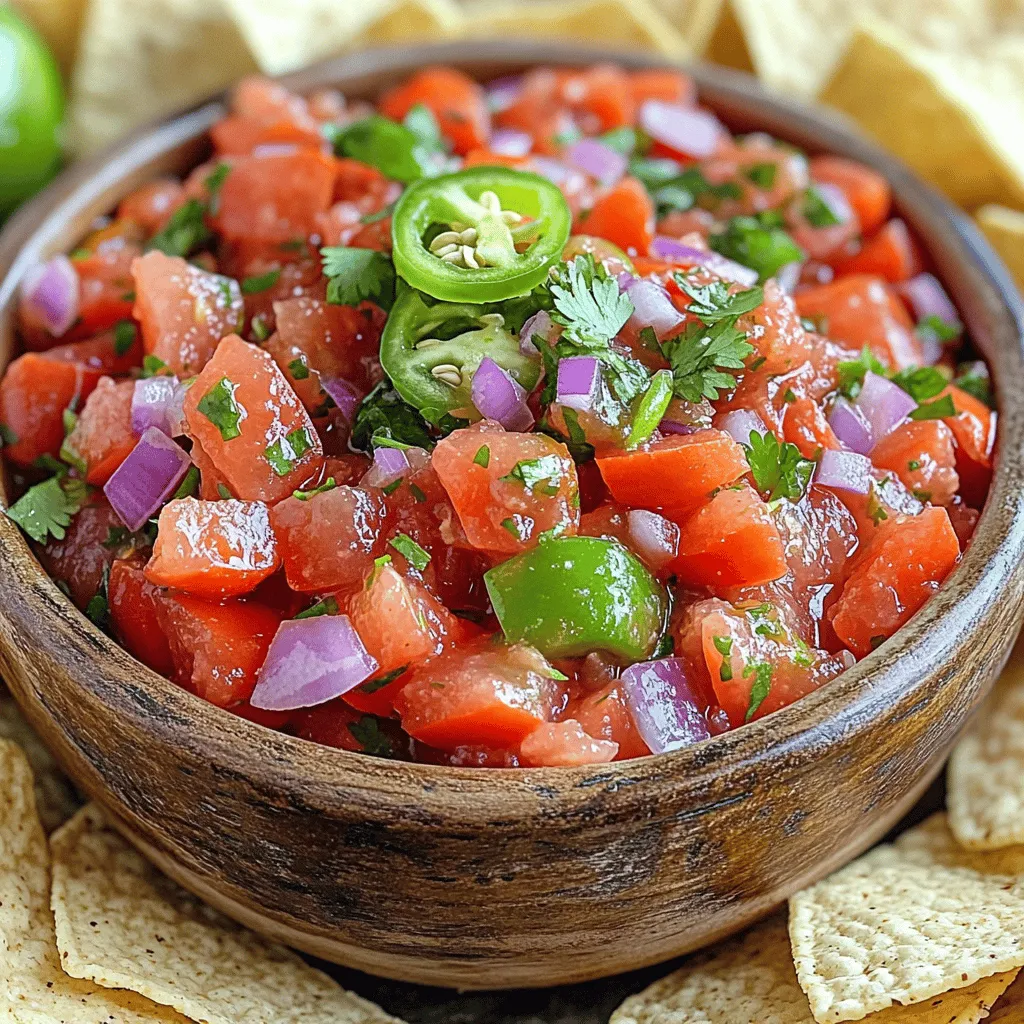Ready to elevate your snack game? This Best Homemade Salsa Fresh and Flavorful Recipe will transform your gatherings. With fresh tomatoes, zesty lime, and spicy jalapeños, your taste buds will thank you. I’ll show you how to mix these vibrant ingredients into a party-perfect dip. Freshness is key, and I’ve got tips to make sure yours stands out. Dive in and discover the joy of homemade salsa that bursts with flavor!
Ingredients
Key Ingredients for Best Homemade Salsa
– 4 ripe tomatoes, diced into small pieces
– 1 small red onion, finely diced
– 1 jalapeño pepper, seeds removed and minced
– 1 cup fresh cilantro, coarsely chopped
– 2 cloves garlic, minced to a paste
– Juice of 1 lime (about 2 tablespoons)
– 1 teaspoon ground cumin for warmth
– Salt and freshly cracked black pepper to taste
Importance of Freshness
Freshness in your salsa makes a big difference.
Selecting the Best Tomatoes
Choose ripe tomatoes for the best flavor. Look for ones that feel firm but slightly soft when you squeeze them. Bright red tomatoes add color and sweetness to your salsa.
Choosing the Right Onion and Pepper
Use red onion for its mild taste and color. Pick a jalapeño that looks smooth and firm. If you want more heat, leave some seeds in the pepper.
Benefits of Fresh Herbs
Fresh cilantro adds a bright taste. It lifts all the flavors in your salsa. Always use fresh herbs instead of dried for the best results.
Optional Ingredients
Feel free to customize your salsa with these options.
Additional Spices
Add chili powder or smoked paprika for depth. Try different spices to find your favorite mix.
Substitute Veggies
You can replace tomatoes with fruits like mango or peach for a twist. Zucchini or bell peppers also work well for a veggie-based salsa.
Sweeteners
If your tomatoes are tart, add a pinch of sugar. This helps balance the flavors. Honey or agave syrup can work too, but start small.
You can find the complete recipe for this fresh and flavorful salsa in the Full Recipe section.
Step-by-Step Instructions
Preparing the Base
Washing and Chopping Vegetables
Start by washing all your vegetables. Use cold water to rinse them well. Next, dice the tomatoes into small pieces. Finely chop the red onion. For the jalapeño, remove the seeds and mince it carefully. This gives heat without being too much. Finally, coarsely chop the fresh cilantro. This will add color and flavor.
Mince Garlic for Even Flavor
Take two cloves of garlic. Mince them into a smooth paste. This step is key. It allows the garlic flavor to spread evenly in the salsa. A little garlic can go a long way in brightening up your dish.
Mixing the Salsa
Combining Fresh Ingredients
In a medium mixing bowl, add your diced tomatoes, red onion, minced jalapeño, and garlic paste. This forms the fresh base of your salsa. Gently stir to mix these ingredients without mashing the tomatoes. You want them to stay plump and juicy.
Adding Herbs and Seasoning
Next, fold in the chopped cilantro. This herb brings freshness and a vibrant taste. Squeeze the juice of one lime over the mixture. Lime adds a zesty kick that brightens the flavors. Then, sprinkle in one teaspoon of ground cumin. This spice adds warmth and depth to your salsa. Finally, season with salt and freshly cracked black pepper. Adjust to taste, starting with a pinch.
Chilling and Adjusting Flavors
Importance of Resting Time
Cover your salsa with plastic wrap or place it in an airtight container. Chill it in the refrigerator for at least 30 minutes. This resting time is important. It helps the flavors blend and become more vibrant.
Tasting and Final Adjustments
Before serving, taste your salsa one last time. You might want to add more lime juice or salt for balance. Adjusting flavors right before serving ensures a fresh taste. Enjoy your salsa with tortilla chips or fresh veggies!
For the complete recipe, check out the Full Recipe link.
Tips & Tricks
Achieving the Best Flavor
To make salsa pop, you must balance acidity and sweetness. Use ripe tomatoes for a natural sweetness. The lime juice adds a bright tang, which complements the tomatoes. Adjust these levels until your taste buds sing!
Next, let’s talk about seasoning. Salt and pepper enhance flavors. Start small; you can always add more. Ground cumin adds warmth and depth. Just a teaspoon makes a big difference. Mix well, then taste. Adjust until it feels just right.
Presentation Tips
When serving salsa, think color and texture. Use a rustic bowl to hold your zesty garden salsa. Surround it with crispy tortilla chips for a fun snack. You can also offer fresh vegetable sticks like carrots and cucumbers for a healthy option.
For garnishing, a sprig of fresh cilantro on top adds a beautiful touch. You can also sprinkle some extra diced tomatoes or jalapeños for color. This makes your dish inviting and delicious.
Common Mistakes to Avoid
One mistake many make is over-mixing the ingredients. When you mix too much, it turns mushy. You want your salsa to have texture. Gently stir until everything is combined, but keep it chunky.
Another common pitfall is using unsuitable ingredients. Always choose fresh, ripe tomatoes and good-quality spices. Avoid canned or dried herbs if possible. They lack the bright taste of fresh herbs. Stick to the basics for the best results with the full recipe.

Variations
Spicy Salsa Options
Incorporating Different Peppers
You can change the heat of your salsa by using different peppers. For a milder taste, select a poblano or banana pepper. If you want more spice, try serrano peppers or even habaneros. Just remember to remove the seeds for less heat.
Adding Heat with Hot Sauce
Another easy way to add spice is with hot sauce. A few drops of your favorite brand can boost flavor and heat. Start with a small amount, then taste. You can always add more if you like it hotter.
Fruit-Based Salsa Variants
Pineapple or Mango Salsa
Fruit can make salsa sweet and fresh. For a tropical twist, add chopped pineapple or mango. These fruits pair well with lime juice and cilantro. They add a fun flavor to your dish.
Peach Salsa for a Sweet Twist
If you enjoy peaches, chop them up and mix them in. Peach salsa is delicious with grilled chicken or fish. The sweetness balances nicely with the spices and lime.
Alternative Preparations
Roasted Salsa
Roasting your ingredients can create a deeper flavor. Roast tomatoes, onions, and peppers together until charred. Then blend them for a smoky taste. This method adds a unique twist to your salsa.
Salsa Verde with Tomatillos
For a green salsa, use tomatillos instead of tomatoes. They give a tangy taste and a vibrant color. Blend them with onion, jalapeño, and cilantro for a fresh and zesty option. It’s perfect for tacos or chips.
For more ideas, check out the Full Recipe to explore these variations in detail.
Storage Info
Best Practices for Storing Salsa
– Use an airtight container to keep your salsa fresh. This keeps out air and moisture.
– Always store your salsa in the fridge. It will stay crisp and tasty longer.
Shelf Life of Homemade Salsa
– How long does it last? Homemade salsa lasts about 5 to 7 days in the fridge.
– Signs of spoilage include off smells, mold, or changes in texture. If you notice these, throw it away.
Freezing Homemade Salsa
– How to properly freeze? Pour your salsa into freezer-safe bags or containers. Leave some space at the top for expansion.
– Thawing tips for quality: Thaw the salsa in the fridge overnight. This helps keep its texture and flavors intact.
For a full recipe, check out my zesty garden salsa.
FAQs
Can I use canned tomatoes for salsa?
Yes, you can use canned tomatoes for salsa. They can save time and still taste good. Make sure to choose whole or diced tomatoes in juice. Drain them well to avoid a watery salsa. Fresh tomatoes are best, but canned can work in a pinch.
How can I make salsa less spicy?
To make salsa less spicy, remove the seeds and membranes from jalapeños. You can also use less jalapeño or switch to a milder pepper, like a bell pepper. Adding sugar or honey can help balance the heat. Mixing in more tomatoes can also tone down the spice.
What is the best way to serve homemade salsa?
Serve homemade salsa in a bowl with tortilla chips on the side. You can also add fresh veggie sticks for a healthy option. For a fun twist, try using it as a topping on tacos or grilled chicken. Always keep it chilled for the best flavor.
How do I know if my salsa is fresh?
Fresh salsa should smell bright and tangy. The colors should be vibrant and the texture chunky. If it looks watery or has an off smell, it may not be fresh. Always taste before serving. If the flavors are dull or off, it’s best to discard it.
Salsa is simple to make with fresh ingredients like tomatoes, onions, and herbs. Choosing quality items is key to great flavor. Follow the steps I shared to prepare and mix your salsa, and don’t skip the chilling step. Remember to taste and adjust flavors for the best balance. Use my tips to present your dish well and avoid common mistakes. With variations and storage tips, making salsa can be creative and fun. Enjoy the vibrant taste of your homemade salsa at your next meal or gathering!

